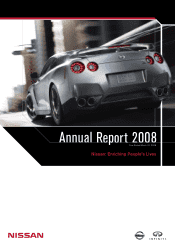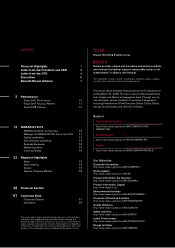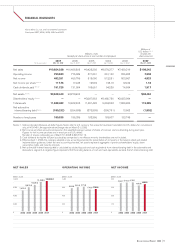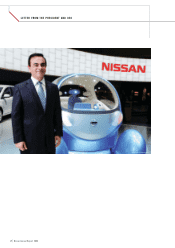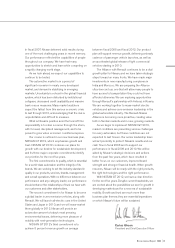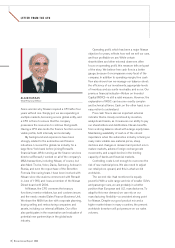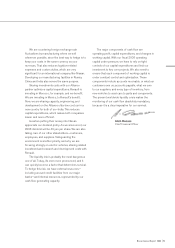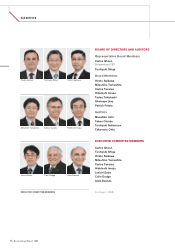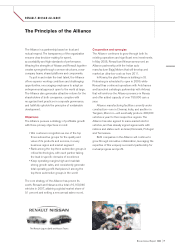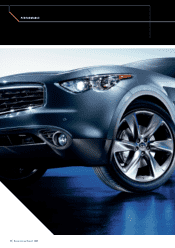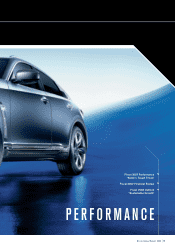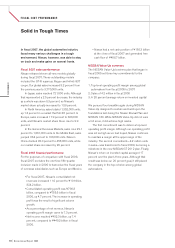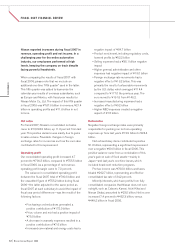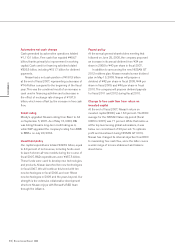Nissan 2008 Annual Report Download - page 6
Download and view the complete annual report
Please find page 6 of the 2008 Nissan annual report below. You can navigate through the pages in the report by either clicking on the pages listed below, or by using the keyword search tool below to find specific information within the annual report.
4Nissan Annual Report 2008
LETTER FROM THE CFO
Some wonder why Nissan required a CFO after four
years without one. Simply put, we are expanding in
multiple markets, becoming a more global entity, and
a CFO is there to ensure that the company
possesses the resources to continue that growth.
Having a CFO also lends the finance function a more
visible profile, both internally and externally.
My background and experience have been
strongly related to the automotive and finance
industries. I covered the global car industry for a
large New York bank before joining Renault’s
financial team. While serving as the finance services
director at Renault, I worked on all of the company’s
M&A transactions, including Nissan, of course, but
also Mack Trucks, Volvo, Dacia, Samsung, Avtovaz in
Russia, and even the repurchase of the Benetton
Formula One racing team. I have been involved with
Nissan since discussions commenced with Renault
in June of 1998, and I was a member of the Nissan
Diesel board until 2004.
At Nissan, the CFO oversees the treasury
functions, investor relations, tax and customs issues
and the newly created Sales Finance Business Unit.
We share the M&A function with corporate planning,
buying, selling and restructuring companies and
assets, including our internal affiliates. Our office
also participates in the examination and evaluation of
potential new partnerships in the global auto
industry.
Operating profit, which has been a major Nissan
objective for years, reflects how well we sell our cars,
and how profitable we are. While certain
shareholders and other external observers often
focus on operating profit, this measure tells only part
of the story. We believe free cash flow is a better
gauge, because it encompasses every facet of the
company. In addition to operating margin, free cash
flow also shows how we manage our balance sheet:
the efficiency of our investments, appropriate levels
of inventory and accounts receivable, and so on. Our
previous financial indicator—Return on Invested
Capital (ROIC)—is still a valid measure. However, the
explanation of ROIC can become overtly complex
and technical at times. Cash, on the other hand, is an
easy notion to understand.
Free cash flow is also an important external
indicator that is closely monitored by investors,
analysts and banks, as it measures our ability to pay
our shareholders and debtholders. Nissan benefits
from a strong balance sheet with a large equity base.
Maintaining availability of cash is of the utmost
importance when the automotive industry is facing so
many risks: volatile raw material prices, steep
declines and changes in demand and product mix in
mature markets, adverse foreign exchange rate
movements, and a rapid decline in the lending
capacity of banks and financial markets.
Controlling costs is not enough to overcome the
risk of raw material prices. We also need to adjust
our retail prices upward, and this is what we did
worldwide.
The second risk I had mentioned is equally
powerful. With a wide range and mix of smaller SUVs
and passenger cars, we are probably in a better
position than European and U.S. manufacturers. To
adapt to this new demand, we can rely on our
manufacturing flexibility—a consistent strong point
for Nissan. Despite our good product mix and a
higher market share in many countries, the present
worldwide downturn will put pressure on our sales
volumes.
ALAIN DASSAS
Chief Financial Officer

